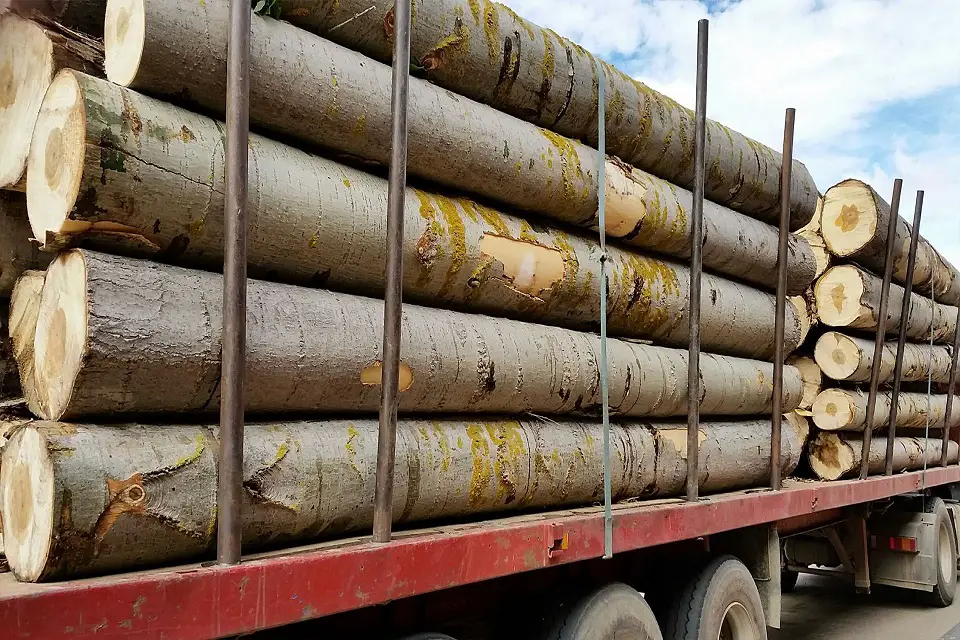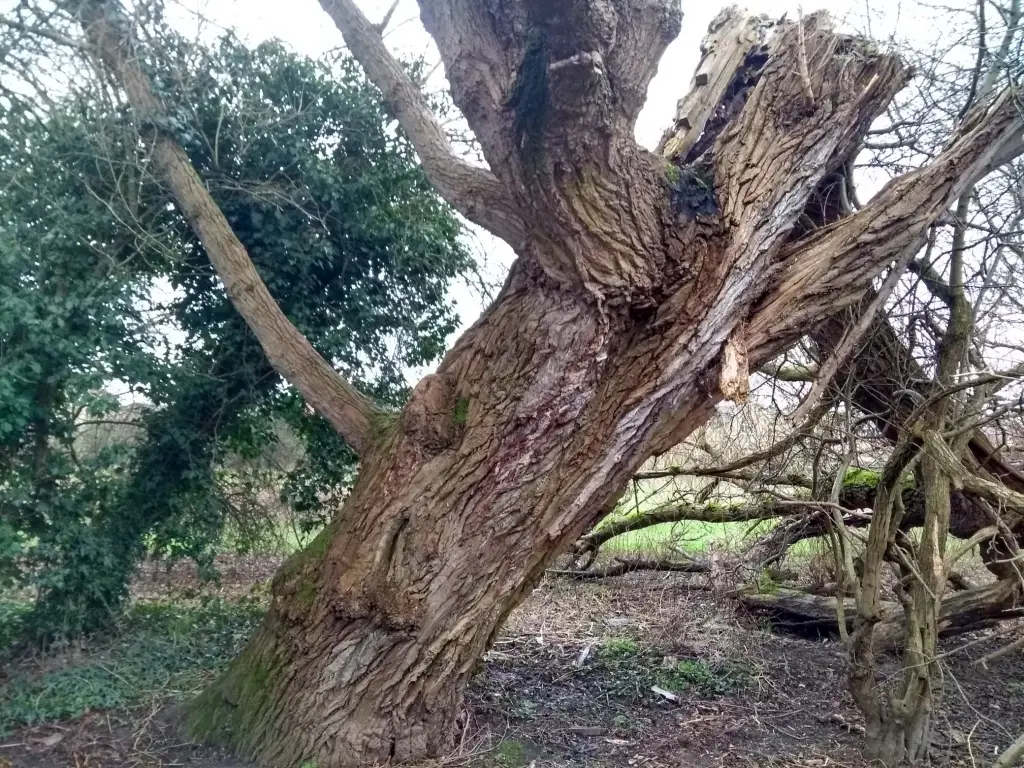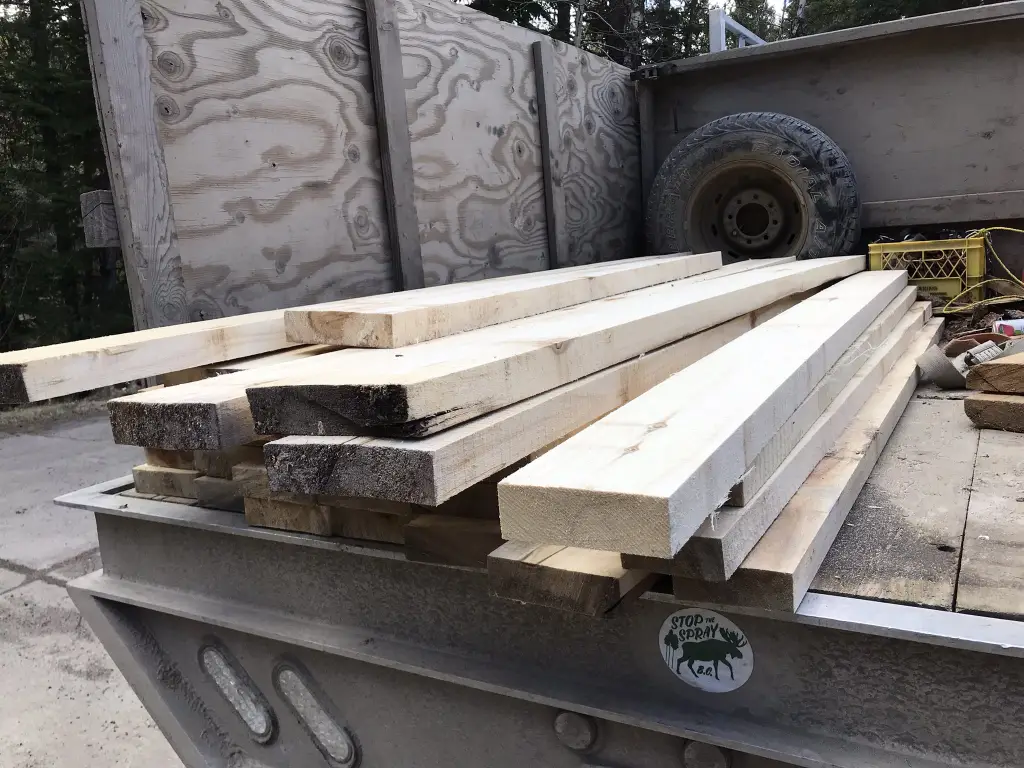Most woodworkers love Poplar and consider it price friendly while offering everything they need to meet their woodworking expectations along with many other benefits.
Let’s jump right into the subject:
What Is Poplar Wood?
Poplar is a hardwood but is not a high-quality wood. It has the same ease of processing as pine. It provides users with various applications, including furniture making, toys, decorations, cabinets, etc. Poplar is inexpensive and is the most commonly used in home improvement.

This post will cover everything you need to know about poplar wood, such as its characteristics, strength, growth, workability, durability, and more.
Let’s keep reading!
Property Characteristics
| Family | Salicaceae |
| Scientific name(s) | Liriodendron tulipifera |
| Origin/Distribution | Eastern United States |
| Type | Hardwood |
| Color | White to light cream and brown, sometimes with mineral stains |
| Odor | No characteristic odor |
| Texture/Grain | Straight, uniform grain, with a medium texture. Low natural luster. |
| Diameter | 30-40 cm |
| Log Durability | No durable |
| Specific gravity | 40, .46 |
| Janka hardness | 540 lbf (2,400 N) |
| Rupture Modulus | 10,100 lbf/in2 (69.7 MPa) |
| Crushing Strength | 5,540 lbf/in2 (38.2 MPa) |
| Elastic Modulus | 1,580,000 lbf/in2 (10.90 GPa) |
| Coeff. of volumetric shrinkage | 12.7% |
| Total tangential shrinkage (TS) | 8.2% |
| Total radial shrinkage (RS) | 4.6% |
| TS/RS ratio | 1.8 |
Origin & History
Also known as American Tulipwood, Poplar comes from the Eastern USA and Canada. They grow mostly in a temperate climate, requiring enough moisture, direct sunlight, and rich nutrients soil. The wood has spread and been distributed to many parts of the world.
Not as it is familiar with other trees, the poplar tree can develop a powerful root system that can go as long as 130ft in diameter. Its length is capable of destroying closer sidewalks or sewage in cities. Another special thing about poplar wood is the early appearance of its flowers early in the spring even before the leaves. Poplar’s fruit range in color from green to reddish capsule, and their maturity takes place during the summer. Their capsule contains a large mineral quantity of miniature seeds.

Appearance and Identification
1. Poplar Tree
Typically, poplar tree has a white, creamy yellow hue and can sometimes be brown or appear with mineral streaks of different colors. At times, many refer to it as rainbow poplar. As a result, most people choose to use the wood for utilitarian purposes (there are better chances that people will prefer using it for drawers than cabinet fronts or match sticks than tables).
The Poplar can become yellow or darken over time.

2. Poplar Leaves
The poplar leaves are triangular to ovate. They are dark green, very tight, and glossy. The leaves can be red-brownish during sprouting. However, you can identify these trees by their leaves. The white Poplar is oval or lobed-shaped with notches on the margins and a silvery underside. The black ones have rounded leaves while the balsam leaves have a triangular shape with serrated margins.
3. Grain
Poplar usually has a straight, inform grain, with a medium texture. Its medium density allows the proper adhesion of paints and glues on the surfaces. This is why the wood has vast applications in many home remodels or facelifts. The straight grain texture makes the wood highly resistant to moisture damage.
4. Odors
Fresh and wet poplar trees give off a notorious and tricky odor. This uncharacteristic smell can sometimes make individual woodworkers not able to predict where to place the odor of the wood.
While some people may find this pleasing; others feel the smell is repugnant and unacceptable. As a result, it is safer to say the smell of poplar trees is sweet when you cut them fresh. Poplar does not have a very strong smell when you season them. In sum, the characterization of the smell of a poplar wood depends on whoever perceives it. The smell preference of the person using the wood counts.
Durability, Treatability, Workability
Poplar is quality and strong wood at the same time with a relative density strength and can bend compared to many other blocks of wood. This is why it remains suitable for moat furniture works such as picture frames, cabinets, and more.
Compared to other woods such as walnut, their softness means that stained services are prone to scratches, damages, or even dents. To increase the scratch and dents resistance of the wood, you can apply a good and quality oil-based paint.
Poplar tress has high stability, making them take paint and stain perfectly. They are low-cost and have high availability in different widths and thicknesses, making them a perfect choice for interior building. Their stability makes them easier to work with.
Poplar is a hardwood. However, not too hard because the terms hardwood and softwood can be confusing. In botanical terms, poplar wood is an angiosperm known as hardwood.
Most people consider Poplar as hardwood. However, Poplar is not as strong as many people think. It is softer compared to mist woods. But, it is harder than softwoods at the same time. When it comes to hardness, they are at the bottom end of the hardness scale, having a 540 lbf for Janka hardness.
Poplar has close grain, helping them to resist warping and a variety of colors from golden brown to almost purplish. On the other hand, yellow Poplar has tannins that provide resistance to decay. Most people use it for siding due to its non-shrinking characteristics of excessive warping. Although Poplar is regarded as hardwoods, they dent easily, making them useful for cabinet making.
Poplar wood is stronger when compared to pine. This is coming according to the value of Janka hardness with the Poplar having 540 lbf compared to pine’s 420 lbf value. It is also important to know that the strength of pine woods varies. For instance, Poplar is stronger than white pine but weaker and softer when compared to the yellow pine with 80 lbf.

Poplar woods are good for furniture making. Their strength makes them ideal to do varieties of furniture fittings such as cabinets, picture frames, and lots more. They are exceptionally good for all kinds of furniture.
Poplar woods are strong enough to make for making bookshelves. However, you may likely face the problem is that the wood gets inevitably painted, veneered, or even hidden. They remain a better option for shelves making due to their hardness.
Poplar is a substantial choice of woods for bedmaking. Most people choose Poplar as one of their choices to make bed frames. They make good bed frames with a significant length of about 16ft.
Poplar is not resistant to weathering conditions. They are only good if they can resist or keep dry and moisture-free. However, if they are provided with proper finishing methods, Poplar can be suitable for outside use. There’s a need for adequate maintenance to keep them in shape and as a result, they are not a resistant wood for weather elements and can decay fast.
Allergies & Toxicity
Not too severe reactions are common about the poplar wood. However, most people reported poplar wood as irritating, and have some of its most common reactions such as respiratory irritation, skin, and even eyes. Some also reported symptoms that are relating to asthma.
You can have allergies to wood. This can mostly happen when you are exposed or coming in contact with a specific wood for the first time. Although this is not common to many, some individuals experience allergic reactions coming in contact with a block of wood for the first time.
When there’s too much exposure to wood dust, it may lead to eyes, nose, and throat irritation. For workers, they may experience breath shortness, dryness, and sore throat. Moreover, they may ha r conjunctivitis (known as the mucous eyes membrane inflammation) or a runny nose. The chemicals in the wood can also lead to dermatitis.
Drying time
Poplar does not dry fast. When it becomes dry, it burns so fast, producing less smoke. At most, you may need to dedicate about 6-12 months for your poplar wood to dry fully. However, you can make it dry faster by splitting it and stacking it off the ground.
Green Poplar can take about ten to twelve months before it becomes fully dried. You may also use it as firewood while it is green but will produce a lot of smoke.
Kiln has heat that helps to dry off resins in softwoods. Depending on the wood species, you may need up to 8 to 16 months to naturally air-dry a wood. On the other hand, you can kiln dry poplar wood usually between six to eight weeks.
Poplar woods can resist moisture if they are treated compared to untreated ones. This helps them from moisture and other harmful elements.
Conservation
Poplar woods are sustainable. Being one of the most efficient trees when it comes to sustainability, they remain one of the fastest-growing trees in the world. They are also environmental-friendly.
Poplar trees help the environment in many ways such as being friendly to the environment by reducing soil erosion. Moreover, poplar help in reducing desertification while increasing the bioversity of natural habitats. Poplar helps in enhancing the landscape. Regardless of whether you are having a poplar finished product, it helps to sequester carbon dioxide from the atmosphere.
Pros and Cons
Pros
- They are hardwood: Poplar woods are generally hard and strong
- Uniform texture: the straight-grained texture makes the wood structure pretty uniform
- No difficulties in working with them: highly workable with machine tools
- Has lightweight: One of the lightest woods in the industry
- Suitable for outdoor use when dry: works well for outdoor applications
- Budget-friendly: relatively inexpensive
Cons
- It can tear up easily: prone to easy splitting
- There’s a need for light sanding: when finishing, it requires fine-grit sandpaper
- Require more paint: doesn’t have an appealing look
- Prone to dent and scratch: not resistant to dent, dings, and scratches.
Growth
Poplar trees grow by spreading their roo systems, giving them some invasive species features. They grow so fast that the roots send up suckers, forming new poplar trees in every direction. Their sucker can come out from stumps or even when some of its branches fall.
Poplar trees can grow at towering feet of about 5 to 8bfeet each year and stop when they get to a maximum height of about 50 ft. This makes them remain a choice for people seeking to grow shade trees or those who crave living privacy screens.
A treated poplar in good conditions can stand the test of time for up to 30 years. Occasionally, some may live even up to 100 years. However, the chances are rare as most of them give up on the disease, pests, or even become rotten within 20 to 30 years.
White poplars grow fast. Different varieties of Poplar have faster growth and can grow to different heights, but they all grow fast. You can expect a growth of 3 to 5 ft of new growth a year.
Poplar can fall easily. They have very fragile branches even a small kid can break them out without much difficulty or effort required. During high winds, the branches can break off and lead to damage to properties.
Price
Poplar is not expensive wood. Poplar remains the cheapest hardwood for construction purposes. This is because it is the softest among other types of hardwoods. The price of a per board feet of Poplar depends on the size and length of the wood.
A poplar wood goes for $4.99/ board feet. The cost depends on the size, width, and length of the wood you’re buying. The larger and bigger the size of the poplar wood you’re rooting for, the costlier it is going to be. The inexpensive cost of Poplar is mainly due to its softness. It is one of the softest of hardwoods.
Poplar wood is cheaper compared to oak. For a more pocket-friendly wood, Poplar is the best choice to go for. In fact, Poplar is one of the most budget-friendly woods you can opt for. Oak grows slower and is denser and more durable than its poplar counterpart.
Types
No, although they have enough strength but not too heavy when compared to certain types of wood. This is why it is suitable for many furniture applications. That a kind of wood is hard does not mean they are heavy. As lightweight wood, Poplar.
Poplar is a kind of hardwood but not too hard.
There are 35 species of poplar trees in the Salicaceae family. However, three popular specifies native to North America are divided into three loose groups: cottonwoods, aspens, and balsam.
A few characteristics differentiate these two blocks of wood. The cottonwood is also referred to as Poplar because it spreads its crown and has a cotton-like seed.
However, certain things differentiate both such as leaves. The leaves of cottonwoods are triangular or heart-shaped compared to the leaves of Poplar. The edges are also slightly serrated. The leaves of Poplar are oval-shaped to oval-lance-like.
Moreover, the Poplar does not get so tall, unlike cottonwoods which can be like 80ft tall to 200ft tall. Not all Poplar types can reach this height. The balsam poplar can be 80ft tall and the black Poplar can be 40 to 50ft tall.
What is Poplar wood used for?
1. Furniture
Poplar is great for furniture due to its relatively high density, compressive strength, and bending strength. This makes them fit into making varieties of furniture such as picture frames, cabinets, furniture, and more. The wood also works well with machine tools. It screws, nails, and glues properly. This way, your tools won’t bend or crack when applying them to the wood.
2. Countertop
Poplar has durability and can resist shock. They have high stability and are great for countertops when you glue them side by side. Generally, countertops need wood that won’t dent when exposed to unfavorable weather conditions or hit hard by a knife or wood. Poplar hardness is enough to hold the hits when grating or crunching food.
3. Burning
They produce a good smoke and spark amount when they are dry. Using them to start your fire will bring a little smoke amount. Burning them will cause smoke that you may find uncomfortable. Another advantage of using poplar wood for burning is that it lights at the speed of light, especially when it’s dry.
4. Firewood
Green poplar wood will lead to excessive smoke but can be used as firewood. It is best enjoyed when fully seasoned. Poplar catches fire quickly and doesn’t give off excessive dark smoke that can pollute the air. In addition, Poplar also helps in releasing warmth to your house in the months between the peak seasons.
5. Cutting board
The direct answer to the question is that Poplar is not suitable for cutting boards. The reason is simple. Poplar comes with so much softness and porosity. These pores cause water or moisture to penetrate the wood and can affect the solidity and durability of the cutting board. Poplar wood sucks up bacteria which can be dangerous to health. Cutting marks can also be deep, making it difficult to clean up.
6. Guitar
Like other woods, poplar wood is great for guitars and can take damage even when it falls so hard. Poplar features an incredible bending strength. To make a guitar, you need wood that can easily bend. Poplar also glues and nails well, making the construction of the wood near perfect.
7. Cabinets
Poplar is hardwood species. As a result, they are one of the softest wood materials suitable for making your cabinets. Cabinets are high-touch areas. With Poplar ‘s amazing and appealing look, your cabinets will maintain its shine regardless of the number of touches.
8. Carving
Poplar’s grain texture makes it suitable for carving. It is easy to cut into it due to its uniformly straight grain. When carving, the kind of wood needed is one that is crisp and softwood. Poplar is known for its high level of softness, making it a perfect pick for intricate carving.
9. Bench
Technically, Poplar is a very dense and heavier hardwood than some lumber. They are good for outdoor benches. Outdoor benches require wood that’s lightweight. Poplar is extremely lightweight. Besides, it stains and paints well, giving your outdoor furnishings a perfect match.
What is the difference between Poplar wood and other woods?
1. pine
Poplar is stronger than pine with a Janka hardness of 540 pound-force (Ibf) compared to white pine’s 420 lbf. While there are various types of pines, some are stronger than Poplar. Pine is softwood wood while Poplar is hardwood, even though it shares some soft features with its pine counterpart.
2. maple
Due to the softness of Poplar, you can easily saw and machine it than a hard Marple. Therefore, they are harder than Poplar. Maple is also stronger than Poplar, making it more suitable for outdoor use than Poplar. What that means is that Poplar can dent and break easily under heavy shock loads.
3. oak
With rarely any grain and a light color of Poplar, oak has a strong and definite grain that will have darker streaks of brown and black in it. The grain of Poplar is hardly noticeable while oak shows visibly definitive and strong grain texture. Besides, Poplar will show some streaks of yellow grain.
4. birch
Poplar and birch are both common for plywood making. However, they have quite several areas of differences. The growing regions, leaf size, growth height, strength, and bark color of each of these woods are different. Birch has affordability and availability. Poplar on the other hand is less dense and fits most utility work.
5. rubberwood
Rubberwood, also known as parawood has strength of about 9500 Psi, a stiffness of 1.3 million psi, and 500 pounds hardness. Poplar, being a hardwood is stronger. Picking poplar wood for furniture is a no-brainer. However, rubberwood is a non-native wood and won’t be suitable for making furniture.
6. Cedar
Poplar as a strong wood is easier to find with compressive strength. On the other hand, Cedar is softwood with natural looks that prevent moths, making it most people’s wood choice. Poplar is the best guy when you want a more budget-friendly wood between Poplar and Cedar. Poplar is more widely used than Cedar in furniture.
7. walnut
Poplar comes as wood with a fine-grained texture. This makes it’s a widely chosen option for furniture over many other hardwoods. However, walnut features as hard, medium-grained wood with lesser appeal for furniture. Meanwhile, walnut fits into cabinet making, medium-strength furniture, and flooring.
8. alder
Poplar is a hardwood, but on the hardness scale, alder ranks higher. Alder is a light brown color wood with subtle grain patterns, straighter when compared to other hardwoods.
Alder is widely used for the body because of its lightweight and full sound. Alder has the same dose of low, mid, and treble, and its timbre is considered the most balanced. Its closed texture makes it easy to finish.
9. basswood
Both are pretty squishy as hardwoods. Poplar is harder when compared to basswood which is more like pine, just 100% softer.
Poplar is generally gray or green, while basswood is white; poplar has a closed grain and usually accepts finishes well, while basswood has nasty green mineral streaks and does not absorb finishes easily. Basswood has a beautiful, warm tone and a good midrange in terms of sound.
Final words
Poplar wood has many qualities above other woods, making it suitable for varieties of furniture applications such as cabinets, picture frames, benches, and lots more. However, it is essential to understand your furniture needs before choosing Poplar. While they are suitable for various applications, they may not be perfect for executing specific projects such as exterior use, cutting boards, and other applications.

My name is Mark, and I am a software engineer and the founder of OnWoodWorkingArt.
I grew up with a passion for woodworking and now have my woodworking studio with a group of like-minded friends who love to create woodworking. My dream is to have a more extensive workshop and be able to make woodworking my main business.